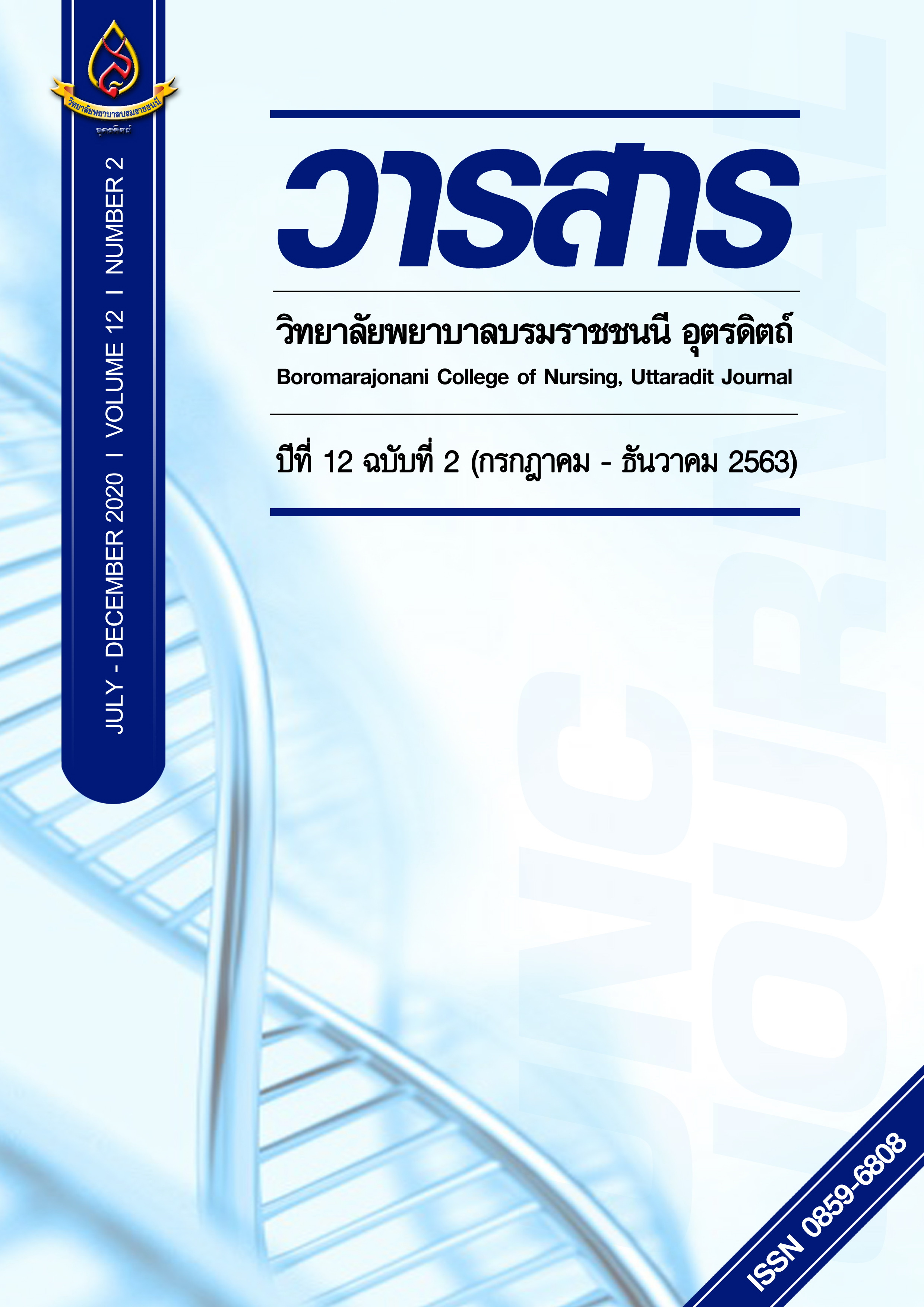การศึกษาคุณภาพและความปลอดภัยสำหรับพยาบาล: เปลี่ยนการศึกษาเปลี่ยนการปฏิบัติ
Main Article Content
บทคัดย่อ
ความปลอดภัยของผู้ป่วย (patient safety) เป็นพื้นฐานสำคัญที่บ่งบอกถึงคุณภาพการดูแลผู้ป่วย การป้องกันไม่ให้ผู้ป่วยได้รับอันตรายจากภาวะแทรกซ้อนที่ไม่พึงประสงค์ (adverse event) เป็นเรื่องที่บุคลากรทางด้านสุขภาพต้องให้ความสำคัญ ดังนั้นการเตรียมบุคลากรทางด้านสุขภาพให้มีความรู้ ความตระหนักและทักษะการปฏิบัติในการดูแลผู้ป่วย โดยเริ่มตั้งแต่การจัดการเรียนการสอนเพื่อส่งเสริมให้นักศึกษามีสมรรถนะทางด้านความปลอดภัยของผู้ป่วยจึงเป็นสิ่งที่สำคัญในการเตรียมเข้าสู่วิชาชีพพยาบาล
บทความนี้เป็นการนำเสนอเกี่ยวกับแนวทางการจัดการศึกษาด้านคุณภาพและความปลอดภัยสำหรับพยาบาล (QSEN: The Quality and Safety Education for Nurse) โดยมีการกำหนดสมรรถนะที่สำคัญสำหรับการเตรียมเข้าสู่พยาบาลวิชาชีพ ซึ่งประกอบด้วยสมรรถนะหลัก 6 ด้าน ดังนี้ 1) การเน้นผู้ป่วยเป็นศูนย์กลาง (Patient center care) 2) การทำงานเป็นทีมและความร่วมมือ (Teamwork and Collaboration) 3) การปฏิบัติ โดยใช้หลักฐานเชิงประจักษ์ (Evidence -base practice) 4) การพัฒนาคุณภาพอย่างต่อเนื่อง (Quality improvement ) 5) ความปลอดภัย (Safety) 6) เทคโนโลยีสารสนเทศ ( Informatics) บนพื้นฐานของความรู้ ทักษะและทัศนคติเกี่ยวกับคุณภาพและความปลอดภัยของผู้ป่วย
Article Details
บทความหรือข้อคิดเห็นใดใดที่ปรากฏในวารสารวิจัยการพยาบาลและวิทยาศาสตร์สุขภาพ เป็นวรรณกรรมของผู้เขียน ซึ่งบรรณาธิการหรือสมาคมศิษย์เก่า ไม่จำเป็นต้องเห็นด้วย และบทความที่ได้รับการตีพิมพ์เผยแพร่ถือเป็นลิขสิทธิ์ของวารสารวิจัยการพยาบาลและวิทยาศาสตร์สุขภาพ
เอกสารอ้างอิง
Australian Council for Safety and Quality in Health Care. (2005). National patient safety education framework. Canberra: Commonwealth of Australia. Retrieved (2020, April 9) from https://www.safetyandquality.gov.au/sites/default/files/migrated/National Patient Safety-Education-Framework-2005.pdf.
Boonmee, P. (2014). Patient safety: The nurse educator’s role. Journal of Nursing and Education,7(3), 2-14. (in Thai).
Boonmee, P., Wongsan, S, M., & Kawila, T. (2018). Knowledge, perception, and awareness of risk management and patient safety towards nursing students at Boromarajonani College of Nursing, Phayao. Journal of Nursing and Education,11(3), 112-124. (in Thai).
Cronenwett, L., Sherwood, G., Gelmon, B.S. (2009). Improving quality and safety education: The QSEN Learning Collaborative. Nursing Outlook, 55, 304-312.
Keeratihattayakorn, T., Panjapiyakul, P., Kurusarttra, A. & Kanchanaboon, P. (2013). Hospital risk management and safety manual 2013. Health Administration Division Ministry of Public Health Thailand. Nonthaburi: Ministry of Public Health. (in Thai).
Khunngern, A. & Kaewchumtra, K. (2010). The feeling of the nursing student in error practices. Journal of Boromarajonani College of Nursing, Bangkok, 26(2), 1-15. (in Thai).
Kumkong, M. (2019). Patient safety: a guideline to nursing practicum. The Southern College Network Journal of Nursing and public Health, 6(1), 216-228. (in Thai).
Nelson, A. L., Waters, T. R., Menzel, N. N., Hughes, N., Hagan, P. C., Powell-Cope, G., Sedlak, C., & Thompson, V. (2007). Effectiveness of an evidence-based curriculum module in nursing schools targeting safe patient handling and movement. International journal of nursing education scholarship, 4(2), 1-19.
Raymond, J., Medves, J., & Godfrey, C. (2016). Perspectives on patient safety among practical nursing students. The Canadian journal of nursing research, 48(2), 41–47. doi.org/10.1177/0844562116664260
Sherwood, G., & Drenkenard, K. (2007). Quality and safety curricula in nursing education :Matching practice realities. Nursing Outlook, 55, 151-155.
Somcharoen, N. (2015). Patient safety curriculum guide multi-professional (WHO): learning integration for the 21st century bachelor’s degree nursing curriculum. Journal of The Royal Thai Army Nurse, 16(3), 1-7. (in Thai).
Teri, M. C., & Larry, G. D. (2010). Frameworks for patient safety in the nursing curriculum. Journal of Nursing Education, 49(10), 559-567.
The Health Accreditation Institute (Public Organization). (2018). Patient safety goals: SIMPLE
Thailand 2018 (update for conference (SIMPLE2). n.p. (in Thai)
The Higher Education Committee. (2017). The announcement of the Ministry of education: qualifications bachelor of nursing science 2017. Bangkok: Ministry of Education (in Thai).
Valiee, S., Fathi, M., Shahoei, R. (2019). Nursing students’ errors and their causes: A qualitative exploration of clinical instructors’ perspectives. Journal of Patient Safety & Quality Improvement, 7(1), 1-8. doi: 10.22038/psj.2019.34505.1190
Walton, M. M., Shaw, T., Barnet, S., & Ross, J. (2006). Developing a national patient safety education framework for Australia. Quality & safety in health care, 15(6), 437–442. https://doi.org/10.1136/qshc.2006.019216
World Health Organization. (2011). Patient safety curriculum gGuide multi-professional edition. World HealthOrganization. Retrieved (2020, April 9) from https://www.who.int/patientsafety/education/mp_curriculum_guide/en/
World Health Organization. (2009). Conceptual framework for the international classification for patient safety version1.1: final technical report January 2009. Geneva: World Health Organization.
World Health Organization. (2007). The world health report 2007: a safer future: global public health security in the 21st century: overview. World Health Organization. Retrieved (2020, April 9) from https://apps.who.int/iris/handle/10665/69698.


